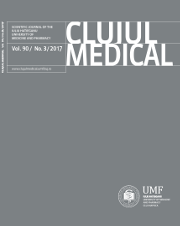EVALUATION OF THE MECHANICAL PROPERTIES AND SURFACE TOPOGRAPHY OF AS-RECEIVED, IMMERSED AND AS-RETRIEVED ORTHODONTIC ARCHWIRES
DOI:
https://doi.org/10.15386/cjmed-729Keywords:
orthodontic archwires, nickel titanium, stainless steel, beta-titanium, mechanical testingAbstract
Background and aims. This experimental study mainly aims at comparing the most important mechanical properties of the new orthodontic archwires, those immersed in fluorinated solution, the as-retrieved ones and the intra-oral used ones.
Methods. A total of 270 arch wires were tested, using tensile testing and three-point bending tests. The tested archwires were made of Stainless Steel, Nickel Titanium, Beta-Titanium and physiognomic covered Nickel Titanium. The tested archwires were subjected to three types of treatments: immersion into fluorinated solution, immersion into carbonated drinks and intra-oral use.
Results. The immersion caused variations of the activation and deactivation forces of all arch wires. The most affected arch wires, in terms of bending characteristics, were the intra-oral used ones.
Conclusions. The alteration of mechanical properties of the orthodontic arch wires by their immersion into fluorinated solutions and soft drinks could not be statistically demonstrated.
Downloads
Additional Files
Published
How to Cite
Issue
Section
License
The authors are required to transfer the copyright of the published paper to the journal. This is done by agreeing to sign the Copyright Assignment Form. Whenever the case, authors are also required to send permissions to reproduce material (such as illustrations) from the copyright holder.

The papers published in the journal are licensed under a Creative Commons Attribution-NonCommercial-NoDerivatives 4.0 International License.

